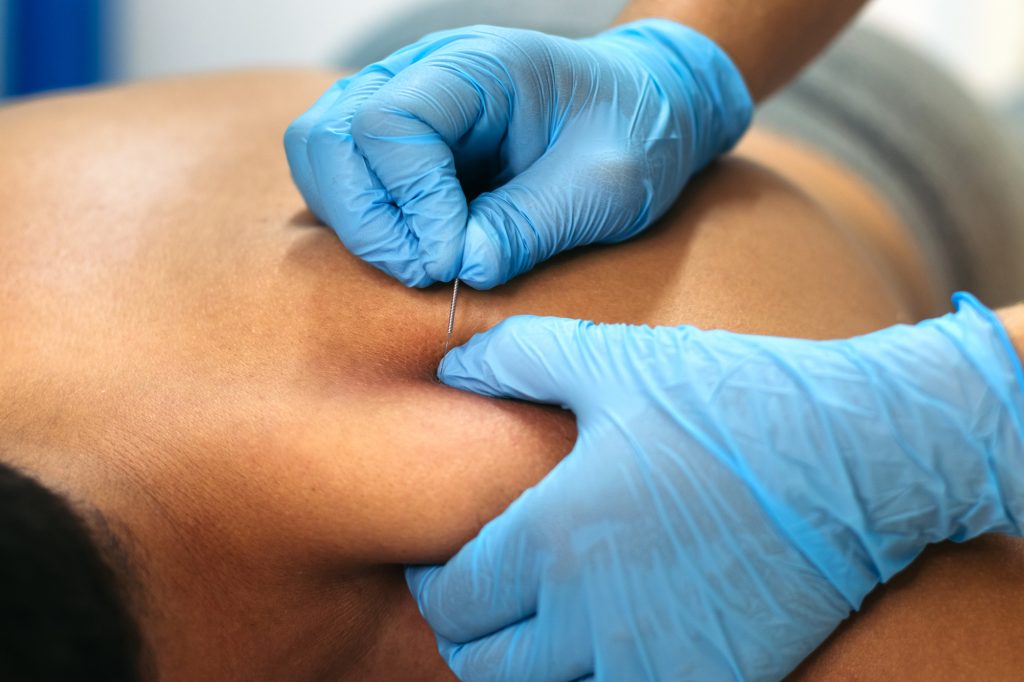Pain and muscle tension can disrupt daily life. This is true for both athletes and those with chronic pain. Enter dry needling. This innovative therapy changes how we approach muscle recovery and pain relief. Dry needling targets the root causes of muscle issues. It offers an effective, science-backed solution.
This article looks at what dry needling is, how it works, its benefits, and why it might be key to your recovery.
What is Dry Needling?
Dry needling uses a thin needle to target specific muscle tissues. It relieves tension, reduces pain, and boosts blood flow. Unlike acupuncture, which is from traditional Chinese medicine, dry needling is from Western medicine. It focuses on trigger points and muscle & tendon dysfunction.
The goal? To target muscle knots—tight bands of connective tissue that restrict movement and cause pain. Inserting the needle into these areas helps the muscle. It relaxes, repairs, and regains function.
How Does Dry Needling Work?
Dry needling directly addresses muscle tightness. Here’s the process:
- Trigger Point Identification: A therapist finds the painful muscle or trigger point.
- Needle Insertion: A tiny needle is carefully inserted into the skin. It must reach the affected muscle.
- Muscle Twitch Response: The needle may cause a localized twitch, indicating tension release.
- Increased Blood Flow: Circulation improves, promoting healing with better oxygen and nutrient delivery.
- Optional Electrical Stimulation: Some therapists connect a electrical stimulator to the needles. It delivers gentle electrical impulses for deeper relief.
Benefits of Dry Needling
Dry needling offers many benefits for acute injuries and chronic conditions.
- Pain Relief: It significantly reduces musculoskeletal pain by releasing tension in muscles and connective tissue. This is effective for many conditions, including, lower back pain, neck pain, and shoulder tension.
- Improved Muscle Function: It restores length and flexibility. So, it boosts function and range of motion.
- Accelerated Recovery: Athletes use dry needling to speed up recovery after intense training. It boosts blood flow and healing.
- Safe and Non-Invasive: This minimally invasive technique is safe for most individuals. Occasionally, there is temporary soreness afterwards, however, there is minimal risk beyond that when performed by a licensed therapist.
Why Choose Functional Dry Needling for Low Back Pain?
Low back pain often leads people to seek manual therapy. Functional dry needling offers a targeted solution by:
- Breaking Up connective tissue restrictions & muscle spasm: Needles release tight tissue bands causing pain.
- Improving Mobility: With less tension, the lower back regains its natural movement range.
- Easing Chronic Discomfort: It’s especially helpful for those with long-term back pain.

The Role of Electrical Stimulation in Dry Needling
An advanced technique in dry needling involves electrical stimulation. Your therapist may connect the needles to an electrical device.
Here’s how it works:
- Muscle Contractions: Gentle electrical impulses cause the muscle to contract and relax, further reducing tension.
- Reduced Post-Needle Soreness: This method minimizes post-treatment soreness and enhances overall effects.
Is Dry Needling Right for You?
If you experience pain, limited mobility, or muscle tightness, dry needling could be transformative. It’s effective for:
- Athletes: Needing quick recovery from workouts or injuries.
- Chronic Pain Sufferers: Managing long-term discomfort in the neck, back, or shoulders.
- Everyday Individuals: Experiencing tension from sitting, stress, or poor posture.
What to Expect During a Dry Needling Session
A typical session at Manual Therapy Associates includes:
- Assessment: Your therapist evaluates your condition and identifies tension areas.
- Preparation: The therapist cleans your skin and explains the procedure.
- Needling: The therapist inserts the needle, focusing on the areas most involved and restricted.
- Post-Treatment Care: You may receive guidance on stretches or exercises to maximize results.
Most people feel relief right away. Some mild soreness is normal for a day or two after treatment.
Common Conditions Treated with Dry Needling
Dry needling is versatile and treats various conditions, including:
- Tension headaches and migraines
- Shoulder impingement and rotator cuff injuries
- Tennis elbow
- Plantar fasciitis
- Sciatica
- Knee pain
- Postural imbalances
Post-Treatment Tips for Maximizing Results
To maximize your dry needling session results:
- Stay Hydrated: Water helps flush out toxins released during treatment.
- Gentle Movement: Light stretching or walking promotes blood flow.
- Avoid Overexertion: Allow muscles to recover by avoiding heavy lifting or intense exercise.
- Apply Heat: A warm compress can soothe post-needling soreness.
Why Choose Manual Therapy Associates for Dry Needling?
At Manual Therapy Associates, we offer personalized care tailored to your needs. Dr. Sandra Do excels in functional dry needling and is dedicated to your health.
- Experienced Team: Dr. Do completed her training in 2012 by Dr. James Dunning of the American Academy of Manipulative Therapy. Her experience and expertise ensure safe, effective treatments.
- State-of-the-Art Techniques: We use cutting-edge methods to address your pain.
- Patient-Centered Approach: Your comfort and well-being are our top priorities.
Conclusion
Dry needling is not just a trend; it’s a proven approach to pain relief and muscle recovery. Whether you’re an athlete, a busy professional, or someone with chronic pain, dry needling offers a powerful path to relief.
Ready to experience the benefits? Trust Manual Therapy Associates to guide you on your journey to better health.
Check out our Facebook!
FAQs
Does dry needling hurt?
Dry needling may cause slight discomfort during needle insertion, but most people describe the sensation as minimal and tolerable.
How many sessions will I need?
The number of sessions varies based on your condition, but many individuals notice significant improvement after just a few treatments.
Is dry needling safe?
When performed by a licensed therapist, dry needling is very safe. Your therapist will follow strict hygiene protocols to ensure your safety.
Can dry needling treat sports injuries?
Yes! Dry needling is highly effective for treating sports-related injuries like muscle strains, tendonitis, and overuse syndromes.
What should I do if I feel sore after treatment?
Mild soreness is normal and typically resolves within 24-48 hours. Apply heat, stay hydrated, and perform gentle stretches to ease discomfort.





